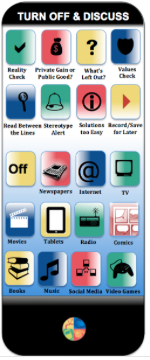About
Learning critical thinking skills
OVERVIEW
This set of activities helps you learn how to use critical questions about digital media, mass media and popular culture with learners of all ages. When students ask and answer key questions, they develop critical thinking skills and activate language and literacy competencies. Some key questions include:
- Who is the author?
- What is the purpose of the message?
- What techniques are used to attract attention?
- What lifestyles, values, and points of view are represented?
- How might different people interpret this differently?
- What was omitted (or "left out")?
To explore these questions, students benefit from understanding and using vocabulary words like: author, purpose, and point of view. For younger children, asking "How does this message make you feel?" can start a conversation about emotions. The question, "What do you see?" helps children use descriptive language to explore framing and composition as choices made by authors. What we love about these questions is that they are iterative, meaning they spark a whole series of questions that we can ask about all of the media we experience. There's no one answer to any of these questions -- rather, these questions are a starting point for exploring the relationships that we have to all of the media in our lives.
ACTIVITIES
1. Start with Experience. Download the image of the Media Literacy Remote Control or purchase a classroom set. Explain the remote by watching Media Literacy Remote Control video to learn how to apply critical questions to any text. Practice using the remote control and ask critical questions using the I-Carly Clip.
2 .Explore Examples to Consider Adaptation to Learners & Contexts. View and discuss two examples of critical analysis in action.
Makeup Girl is a video created by a college student where she uses the critical questions to comment on a YouTube video featuring a 5-year old makeup expert.
Analyzing a Pine-Sol Ad features a 7-year old reading a magazine and and applying the critical questions.
3. Compose, Create and Take Action. Check out how easy it is to make your own screencast -- and listen to children analyze a TV ad -- by viewing Screencasting Demo: Critical Questions. Then use the Lesson Plan: Screencasting Critical Questions to structure the process of making screencasts for media literacy with your students.
GUIDING QUESTIONS FOR REFLECTION:
- How might you explain one of the key questions for younger and older learners? How would you explain why these questions are important?
- How might teachers collaborate to apply key questions to texts in a variety of school subjects and different learning environments?
- What are some of the short-term and long-term consequences of learning to ask critical questions about what we see, read, watch, hear and experience?
- How might the classroom environment change as children internalize the practice of asking critical questions?





Conversation